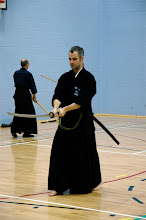In a recent post on Facebook, the topic of how a woman
should wear an obi and a hakama was discussed comprehensively; the main issue
being the tendency for women’s hips to be more prominent than men’s thus
leading to the hakama and obi falling below the hip bone during practice. I
don’t want to get into this any further as, as I said, the topic was discussed
comprehensively and I think a resolution was somewhat reached.
What I do want to explore though is one point that came up during
this discussion, the need to redress oneself during training. Like any good
subjective topic to be discussed, I’ll avoid going straight to the solution and
instead go timey wimey around in a circle until we land, “splat”, at the
conclusion.
First, let’s think about the fundamental wearing of the
sword as it originated (whether that’s in battle or on the streets of
Tokugawa-period Edo. The principle underlying most of iaido is the idea of a
sudden encounter that requires the quick or hidden drawing of the blade, often
a forestalling of the opponent followed by a decisive strike. If this is in an
iai-type “in the street” or “while having a nice cuppa tea” situation then the
idea here is that this is a rare one-off occurrence. There isn’t a requirement
to be repeating this type of self-defence several times per day (this is a
hazarded guess; I wasn’t there in Edo so I wouldn’t know).
If you prefer your style of iai to originate from the
pre-Edo era of battlefield swordsmanship then a sudden draw might not be quite
as common as simply drawing your sword, walking/running/riding into the
battlefield and flinging/pouncing/announcing yourself on your intended
opponent(s).
The point here is that in neither of these originating
concepts is there the requirement to be continually drawing and resheathing
your sword, thankyouverymuch.
I’m now going to take a leap onto another side of this
discussion, let’s call it “Countermeasures Against Chaos” (CAC or Midaredome in
Japanese), by this I mean, what do people do to stop their keikogi from getting
in a mess. In Europe we have had very useful input from several different
Japanese sensei. While I wasn’t in attendance, I know that Kinomoto Sensei
spent some time explaining and demonstrating how women should wear their keikogi.
Previously, Hayashi Sensei and Ueda Sensei have explained how using a towel
wrapped around the waist can help reduce hip prominence and how to tie the obi
to prevent backside bustle (i.e. a flat knot to stop it looking like a van has
parked in the back of your hakama). Oshita Sensei and Morita Sensei both
demonstrated a very neat solution of sewing Velcro into key parts of the
keikogi and using pins to keep everything together. On the basis that I have
never seen Oshita Sensei looking anything other than extremely smart, I would
guess that this is highly successful. In fact all of these sensei always look
smart and straight when we see them…
…and this brings us closer to the conclusion. When we talk
about redressing during practice (due to things like, sayabiki causing your
hakama and obi to slowly separate and your jacket to lose its straightness)
this is in the context of doing dozens, if not a few hundred kata/suburi during
a training session lasting from 1-4 hours at a time. Sorry to break any illusions
but when we see our teachers at seminars outside of Japan, they are doing some
demonstrations and then teaching, they aren’t doing the training workload that
seminar participants are expected to undertake. As someone who has taught at a
few events myself I can promise you that there’s no better way to keep your
keikogi nice and tidy than by just simply walking around and giving feedback.
This isn’t me disparaging teachers; this is the reality of
the situation. Even so, you still sometimes see our teachers straightening
their clothes, sometimes redressing completely during the break.
And so onto the conclusion:
Light is both a wave AND a particle AND a smell….oops,
sorry, wrong blog.
If your keikogi is falling apart and you end up looking like
a bag of rags after, say, five kata, then there probably is something you can
do to improve that. Correct tightness of obi (not too tight in my opinion),
correct tightness of hakama himo (a little tighter, in my opinion), the
insertion of a safety pin in the lapel (not a bad idea in a grading) are all
good things to do.
If your keikogi is looking untidy after 30 kata…so what?
Stop for a few seconds and tidy yourself up. If it requires a quick redress
then step to the side and do so. Don’t worry about it. Actually, at the end of
a session, if my students look like they have been dragged through a Rage
Against The Machine concert then I like it, it means they have been training
hard. There’s nothing wrong with this.
My main point is that there’s nothing wrong with redressing
yourself or having to tidy yourself now and again. It’s an inevitable outcome
of doing some training. If you see someone who always looks smart with their
uwagi, obi and hakama perfectly aligned then it means that they probably
haven’t done any training since putting it on this way.
Embrace the scruffiness of training!





Dear Andy, please excuse this pragmatic question... can you help me with a link to the facebook discussion? Naturally, we have this "problem" with some of ourfemale students and practical hints would be great.
ReplyDelete
ReplyDeleteWow what an amazing blog. I'm so happy to find your blog. I will definitely
check your other post as well.
Martial Arts NYC Adults
Shotokan Karate Queens NY